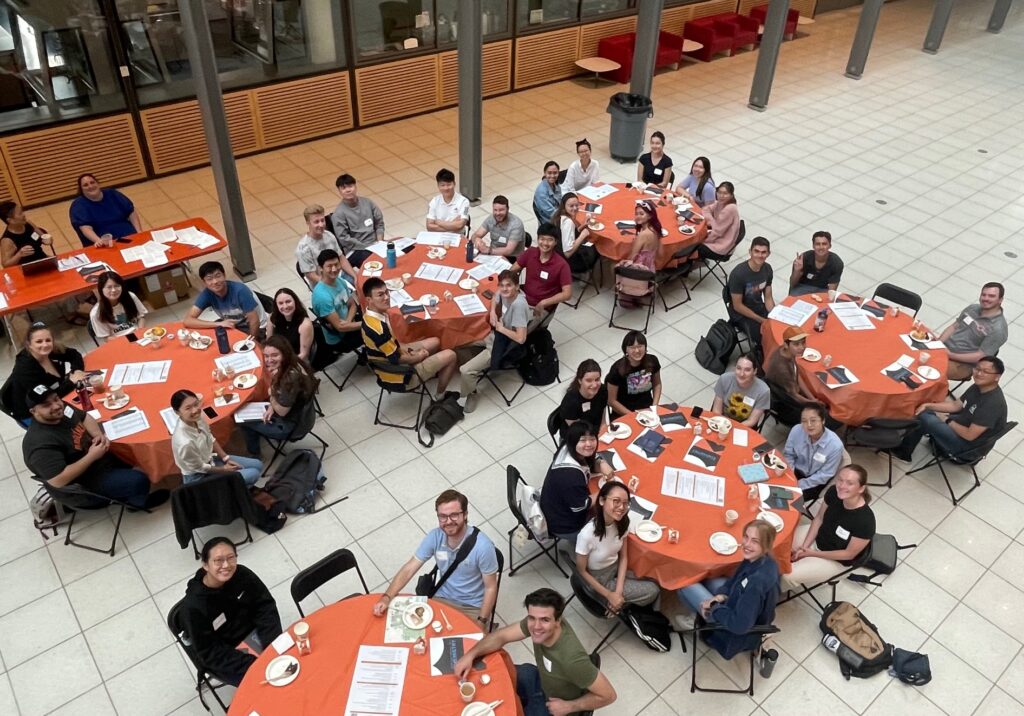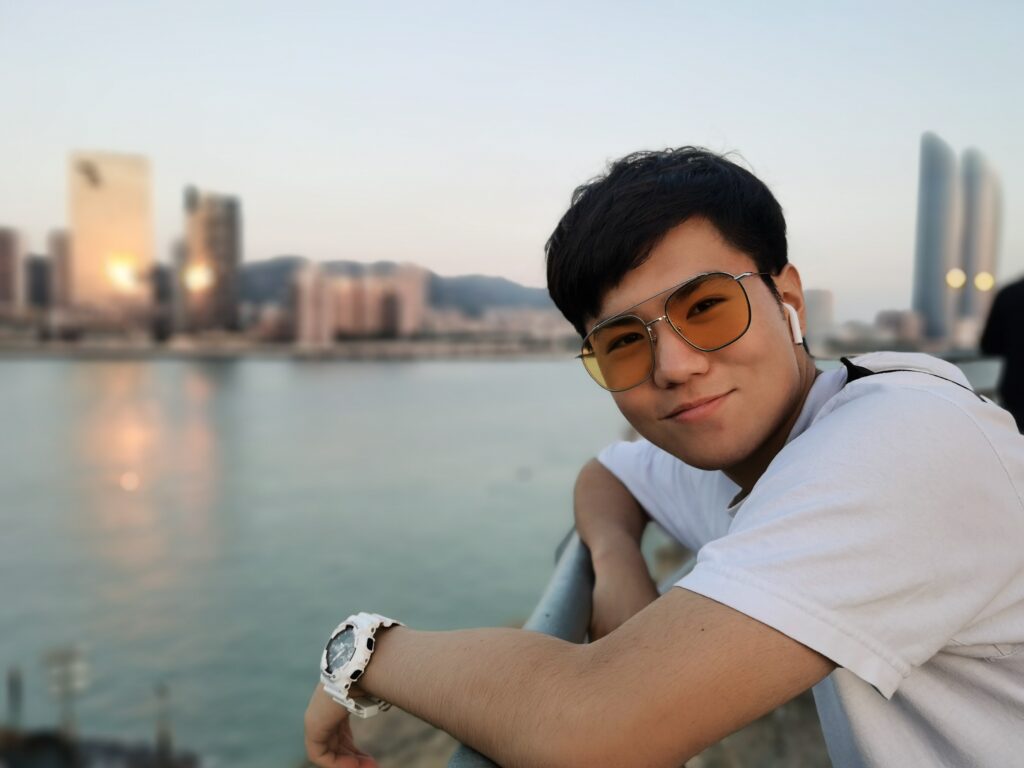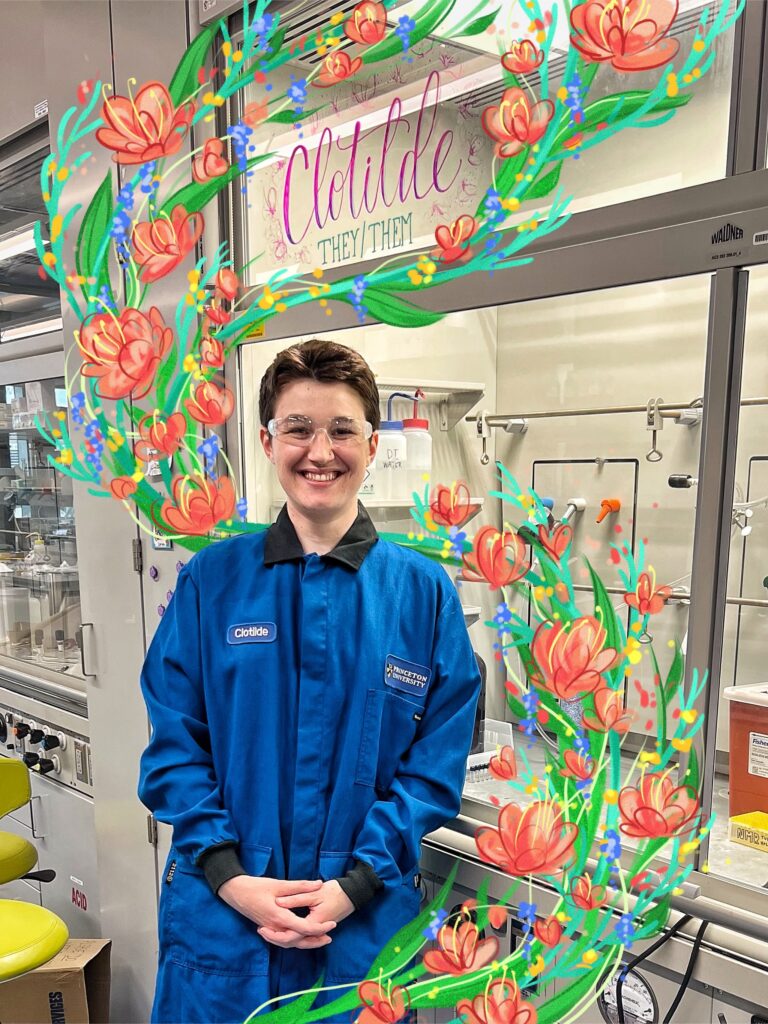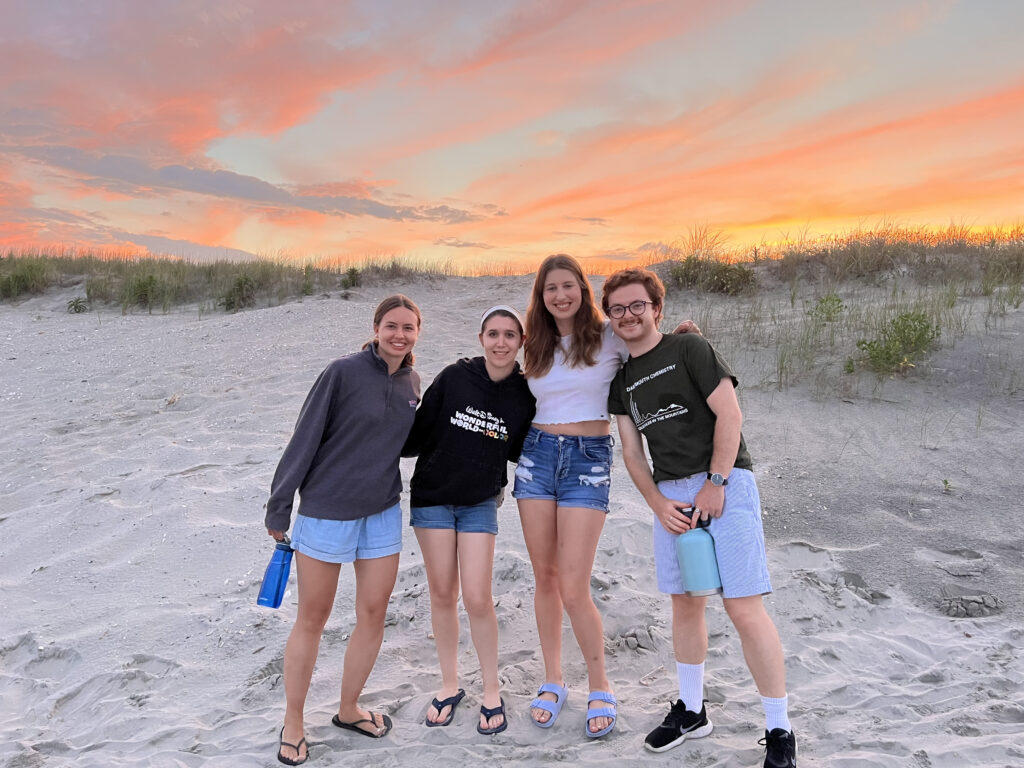An Introduction to the New Cohort Through Five Grad Students

The Department of Chemistry welcomed 36 new graduate students to Frick Laboratory last month, young chemists who arrived from universities around the country and around the world. Over the next five years, we hope to feature all of them in stories as they publish papers, win awards, and grow into their doctoral careers. But for now, we offer these five profiles as representative of the Great Cohort of 2023 and all there is to come.
Gabriella Sonderegger (Scholes Lab/Kunin Lab)
Three times in almost as many years, Gabriella Sonderegger has switched her chemistry field, from organic chemistry at the University of the Pacific where she was an undergrad to nuclear chemistry and data analysis as an intern at the Lawrence Berkeley National Laboratory to physical chemistry in the Scholes Lab today, where she is planning to get up to speed this fall by assembling a laser.

Gabriella Sonderegger with her mother on a hiking trip in California.
“I’ve never worked with lasers before,” she said. “So I thought maybe, if I’m the one who has to put it together, I’ll have a better idea how they work.”
Sonderegger, who hails from San Ramon, California (and loves it there), said one of her goals over the next five years is to figure out how to generate her own field of inquiry.
“I’ve done a lot of being given a project where they’ll say, we need this product, now go make it. I didn’t have much context on why I was making something or how we decided to make this thing instead of that one,” says Sonderegger. “I’d love to get to a point where I can come up with these ideas on my own, having the scientific background to be able to design a project rather than just building the house.”
Sonderegger will switch over to the Kunin Lab in January when Assistant Professor Alice Kunin arrives on campus after completing her own postdoctoral work. Sonderegger met Kunin during visiting weekend last spring and was “really interested” in her work on novel spectroscopic approaches to probe the ultrafast dynamics of optically excited states in materials.
In her spare time, Sonderegger plans to do lots of reading—she’s been on an Alice Hoffman kick lately—and developing a prowess in crochet.
Hantao “Tony” Qiang (Rabinowitz Lab)
Hantao “Tony” Qiang originally came to Princeton Chemistry to study with Josh Rabinowitz. But he’s already been recruited away from that work to the lab of the Ludwig Princeton Branch’s newest faculty member, Michael Skinnider.
It was Qiang’s background in computation and data analysis that led to Skinnider’s interest, he said. He has a degree in computer science. He also has a degree in chemistry. And a minor in biochemistry. And yet another minor in math. College, for him, was an act of exploration.

Hantao “Tony” Qiang leaning in Xiamen, China, during his summer vacation.
“I think Josh and Michael could see that my background really fits in with Michael’s goal of computational work and he’s recruiting for more students, so he reached out to me,” said Qiang. “I’ve never done such a thing so it’s a little intimidating. At the same time, it is very advanced, cutting-edge technology, which I’d really like to pursue.”
Qiang was raised in Beijing, China. Knowing he wanted to pursue a Ph.D. in the United States, he sought an undergraduate degree here as a way of warming up to the task. He eventually earned it at Carleton College in Northfield, Minnesota. Qiang acknowledges the school is in “the middle of nowhere,” but it sold Qiang on the idea of a liberal arts education, something that was not much in evidence in China.
Still, he wanted to study chemistry for a personal reason. “When I was in high school, one of my family members got thyroid cancer,” he said. “I was really sad and astonished and as a kid I didn’t know what to do. But what I know now about chemistry is that it can solve real-world problems and help me save someone I love.”
Qiang said his family member, today, is doing just fine.
Clotilde Tagnon (Stache lab)
Clotilde Tagnon was raised in Texas, mostly, but does not see that as a defining factor. They see themselves as French, first and foremost, born of parents who met in Grenoble, France and who raised four children with a Gallic sensibility.
“My grandfather on my mom’s side, just two generations above me, would wake up in rural France when he was five years old to take the cows up the mountain,” they said. “All of my heritage is in France.”

Clotilde Tagnon in the Stache Lab, embellished.
Until Clotilde was 15, they wanted to be a concept artist and once even researched the possibilities that career would afford. But along the way, they also discovered a deep love of sustainable chemistry and, after an undergraduate degree from the University of Texas at Austin, came to Princeton Chemistry to pursue it through research in the depolymerization of plastics. Indeed, they were second-author in July on a paper published in the Journal of the American Chemical Society (JACS) about a selective chemical recycling strategy facilitated by photothermal carbon quantum dots.
Asked how they knew that chemistry, and not a career in art, was the right path, Tagnon was philosophical.
“All I can do is continue to show up every day and try to do what I think is the right thing to do in the right direction to do it in, and 98% of the time it is the right thing,” they said. “So with science in particular, just science, I still wake up every day and ask, am I good enough to do this? I guess we’ll see. It is 100% blind faith.”
Besides, they said, there is always retirement one day. Plenty of time for art then, they said.
Theodore Press (MacMillan Lab)
By his own admission, Theodore “Teddy” Press has a lot of social energy. It served him well as an undergraduate at Dartmouth College, and then during a research stint at Massachusetts General Hospital through Harvard Medical School, and now, joining the MacMillan Lab, one of Princeton’s largest research groups, to work with µMap technology in the immunology space.
Press grew up in New Jersey. His father worked as an environmental scientist on superfund remediation and his mother worked in the pharmaceutical industry: “My parents were very science-y.” But it was really his high school chemistry teacher who promoted a love of chemistry and convinced Press that it was something he could pursue in graduate school.

Theodore Press with friends in Avalon, New Jersey.
Press chose Princeton Chemistry last spring because he liked the energy of visiting weekend and how passionate students were about the work they’re doing.
“It didn’t hurt that the facilities here are gorgeous, and that the grad department just feels like a well-oiled machine,” he said. “I think the energy was infectious.”
He likes hiking, reading, baking Christmas cookies with his family, and photography. He also raced with a ski team in college, excelling in both slalom and giant slalom. And he’s recently been assigned not one, but three mentors in the MacMillan Lab.
“I love it,” Press said. “I hope to continue that energy.”
Charlene Gopatta (MacMillan Lab)
A wandering salesman, knocking at her family’s door in Bangkok, Thailand years ago, provided the first impetus for Charlene Gopatta to study chemistry. The salesman was selling water filtration systems. Just eight years old at the time, Gopatta was intrigued: “I thought it was so fascinating that one could manipulate these chemical reactions to change their macroscopic properties completely. That’s why I wanted to dig deeper into chemistry.”
Gopatta attended the Emma Willard School in Troy, New York and then got her undergraduate degree in chemistry from the University of Illinois Urbana-Champaign. She recalls her childhood as filled with study that prepared her well for the challenge of grad school.

Charlene Gopatta, seated at top, with friends.
“Growing up in Thailand, I definitely studied a lot — all day, from 7 a.m. to midnight, even during the summer. It is like a norm for most students that our time is solely devoted to reading and studying. I would say that the Thai educational system prepared us really well.” she said.
Gopatta ran across information on David MacMillan’s research in photoredox catalysis when she was preparing to apply to graduate school. She also had the benefit of interesting conversations with MacMillan Lab fourth-year Andria Pace, her former T.A. at UIUC. But it was visiting weekend last spring that really finalized the decision.
“During my visitation weekend, I listened to Dave’s presentation,” she said. “I became even more intrigued by how one could harness the properties of visible light to overcome challenges in bond-forming reactions. That was when I realized photoredox chemistry was what I wanted to do.”
Gopatta also hopes to refine her skills in science communications, learning to translate her work into terms that can be grasped by lay audiences.
“You may have a high-impact and really interesting project going on, but if you cannot communicate your science to broader audiences, in some sense, it might not turn out to be as impactful as you expected. I don’t want that.”
